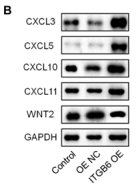CXCL11 Antibody - #DF9917
| 製品: | CXCL11 Antibody |
| カタログ: | DF9917 |
| タンパク質の説明: | Rabbit polyclonal antibody to CXCL11 |
| アプリケーション: | WB IHC |
| Cited expt.: | WB, IHC |
| 反応性: | Human |
| 予測: | Pig, Bovine, Horse, Sheep, Rabbit |
| 分子量: | 10 kDa; 10kD(Calculated). |
| ユニプロット: | O14625 |
| RRID: | AB_2843111 |
製品説明
*The optimal dilutions should be determined by the end user.
*Tips:
WB: For western blot detection of denatured protein samples. IHC: For immunohistochemical detection of paraffin sections (IHC-p) or frozen sections (IHC-f) of tissue samples. IF/ICC: For immunofluorescence detection of cell samples. ELISA(peptide): For ELISA detection of antigenic peptide.
引用形式: Affinity Biosciences Cat# DF9917, RRID:AB_2843111.
折りたたみ/展開
b R1; b-R1; Beta-R1; betaR1; C-X-C motif chemokine 11; Chemokine (C-X-C motif) ligand 11; Chemokine C-X-C motif ligand 11; CXC11; CXCL11; CXL11_HUMAN; H174; I TAC; I-TAC; Interferon gamma inducible protein 9; Interferon gamma-inducible protein 9; Interferon inducible T cell alpha chemoattractant; Interferon-inducible T-cell a chemoattractant I-TAC; Interferon-inducible T-cell alpha chemoattractant; IP 9; IP-9; IP9; ITAC; MGC102770; SCYB11; SCYB9B; Small inducible cytokine B11; Small inducible cytokine subfamily B (Cys-X-Cys) member 11; Small inducible cytokine subfamily B (Cys-X-Cys) member 9B; Small inducible cytokine subfamily B, member 11; Small inducible cytokine subfamily B, member 9B; Small-inducible cytokine B11;
免疫原
A synthesized peptide derived from human CXCL11, corresponding to a region within the internal amino acids.
High levels in peripheral blood leukocytes, pancreas and liver astrocytes. Moderate levels in thymus, spleen and lung. Low levels in placenta, prostate and small intestine. Also found in epidermal basal layer keratinocytes in skin disorders.
- O14625 CXL11_HUMAN:
- Protein BLAST With
- NCBI/
- ExPASy/
- Uniprot
MSVKGMAIALAVILCATVVQGFPMFKRGRCLCIGPGVKAVKVADIEKASIMYPSNNCDKIEVIITLKENKGQRCLNPKSKQARLIIKKVERKNF
種類予測
Score>80(red) has high confidence and is suggested to be used for WB detection. *The prediction model is mainly based on the alignment of immunogen sequences, the results are for reference only, not as the basis of quality assurance.
High(score>80) Medium(80>score>50) Low(score<50) No confidence
研究背景
Chemotactic for interleukin-activated T-cells but not unstimulated T-cells, neutrophils or monocytes. Induces calcium release in activated T-cells. Binds to CXCR3. May play an important role in CNS diseases which involve T-cell recruitment. May play a role in skin immune responses.
Secreted.
High levels in peripheral blood leukocytes, pancreas and liver astrocytes. Moderate levels in thymus, spleen and lung. Low levels in placenta, prostate and small intestine. Also found in epidermal basal layer keratinocytes in skin disorders.
Belongs to the intercrine alpha (chemokine CxC) family.
研究領域
· Environmental Information Processing > Signaling molecules and interaction > Cytokine-cytokine receptor interaction. (View pathway)
· Organismal Systems > Immune system > Chemokine signaling pathway. (View pathway)
· Organismal Systems > Immune system > Toll-like receptor signaling pathway. (View pathway)
参考文献
Application: IHC Species: Human Sample: tubal tuberculosis
Application: WB Species: Human Sample:
Restrictive clause
Affinity Biosciences tests all products strictly. Citations are provided as a resource for additional applications that have not been validated by Affinity Biosciences. Please choose the appropriate format for each application and consult Materials and Methods sections for additional details about the use of any product in these publications.
For Research Use Only.
Not for use in diagnostic or therapeutic procedures. Not for resale. Not for distribution without written consent. Affinity Biosciences will not be held responsible for patent infringement or other violations that may occur with the use of our products. Affinity Biosciences, Affinity Biosciences Logo and all other trademarks are the property of Affinity Biosciences LTD.

